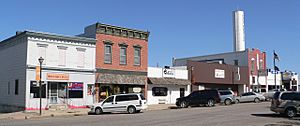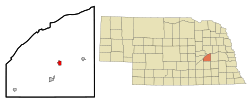Osceola, Nebraska facts for kids
Quick facts for kids
Osceola, Nebraska
|
|
|---|---|

Downtown Osceola: north side of courthouse square
|
|

Location of Osceola, Nebraska
|
|
| Country | United States |
| State | Nebraska |
| County | Polk |
| Area | |
| • Total | 0.92 sq mi (2.39 km2) |
| • Land | 0.92 sq mi (2.39 km2) |
| • Water | 0.00 sq mi (0.00 km2) |
| Elevation | 1,647 ft (502 m) |
| Population
(2020)
|
|
| • Total | 875 |
| • Density | 949.02/sq mi (366.43/km2) |
| Time zone | UTC−6 (Central (CST)) |
| • Summer (DST) | UTC−5 (CDT) |
| ZIP code |
68651
|
| Area code(s) | 402 |
| FIPS code | 31-37525 |
| GNIS feature ID | 2396093 |
| U.S. Routes | |
| Website | osceolanebraska.com |
Osceola is a small city in Polk County, Nebraska, United States. It is the main city, also known as the county seat, of Polk County. In 2020, about 875 people lived there.
Contents
History of Osceola
Early Settlers and Naming
The first people to settle in Osceola arrived in October 1868. Among them were Reverend James Query and Vinson Perry Davis. Davis is believed to have named the town. He named it after a city in Iowa that was also called Osceola. That city was named after Chief Osceola of the Seminole people.
Town Organization and Growth
After three years, the town was officially organized in 1871. This happened thanks to pioneers William Francis Kimmel and John Hopwood Mickey. People voted to place the town in the "geographic center of the county."
In the spring of 1872, a courthouse was built. A general store opened in May, and a post office was built that summer. The post office connected Osceola to Lincoln and Ulysses. The town's first public school opened by the end of that year.
Religion and Education
In 1873, Methodism came to Osceola. A Methodist church was finished by 1878. The next year, Nebraska Wesleyan college started in this church. It had 11 students and 4 teachers. Later, the school moved to Fullerton.
Railroad and Incorporation
The Omaha and Republican Valley Railroad reached Osceola in 1879. They even named a locomotive after the city, but it was later just called "number 9." On August 26, 1881, Osceola officially became a village. This happened after its population grew to 200 people. The city's population reached its highest point in 1920, with 1,200 residents.
Local Newspaper
A newspaper called The Homesteader began in August 1873. It changed its name to the Osceola Record in March 1876. Today, it is known as the Polk County News. About 1,850 people subscribe to it.
Challenges and Improvements
Osceola faced a drought from 1893 to 1895. In 1895, a two-hour fire burned down most of the city. Only two buildings were left standing.
A sewage plant was built for the city in 1958. It was made bigger in 2007. In 1985, Hanna Keelan created a full city plan for Osceola.
Centennial Celebrations
In 1971, Osceola celebrated its 100th birthday. Twenty years later, people celebrated the 100th anniversary of St. Mary's Catholic Church, which is just outside of town.
Geography of Osceola
Location and Size
Osceola covers an area of about 0.92 square miles (2.39 square kilometers). All of this area is land.
Nearby Cities
The closest cities to Osceola are Stromsburg and Shelby. Both are about 6.8 miles (10.9 km) away by paved roads. Polk, which is in the same county, is about 19 miles (30.6 km) away. Outside of Polk County, Silver Creek is the closest city, about 11 miles (17.7 km) away.
Climate in Osceola
Osceola has a humid continental climate. This means it has cold, dry winters and warm, humid summers. Most rain falls in the late spring and summer. The city gets about 28.79 inches (731 mm) of rain each year.
The hottest temperature ever recorded in Osceola was 112°F (44°C) in 1954. The coldest was -31°F (-35°C) in 2021.
| Climate data for Osceola, Nebraska (1991–2020 normals, extremes 1907–present) | |||||||||||||
|---|---|---|---|---|---|---|---|---|---|---|---|---|---|
| Month | Jan | Feb | Mar | Apr | May | Jun | Jul | Aug | Sep | Oct | Nov | Dec | Year |
| Record high °F (°C) | 73 (23) |
81 (27) |
90 (32) |
98 (37) |
104 (40) |
110 (43) |
116 (47) |
112 (44) |
105 (41) |
93 (34) |
83 (28) |
72 (22) |
116 (47) |
| Mean maximum °F (°C) | 56.7 (13.7) |
62.5 (16.9) |
75.4 (24.1) |
84.5 (29.2) |
90.6 (32.6) |
93.9 (34.4) |
95.0 (35.0) |
93.3 (34.1) |
91.2 (32.9) |
84.7 (29.3) |
72.2 (22.3) |
58.4 (14.7) |
96.8 (36.0) |
| Mean daily maximum °F (°C) | 34.3 (1.3) |
39.0 (3.9) |
51.6 (10.9) |
62.7 (17.1) |
73.0 (22.8) |
82.4 (28.0) |
86.0 (30.0) |
83.8 (28.8) |
78.0 (25.6) |
65.1 (18.4) |
50.3 (10.2) |
37.4 (3.0) |
62.0 (16.7) |
| Daily mean °F (°C) | 23.7 (−4.6) |
27.7 (−2.4) |
38.9 (3.8) |
49.8 (9.9) |
61.5 (16.4) |
71.5 (21.9) |
75.4 (24.1) |
73.0 (22.8) |
65.6 (18.7) |
52.5 (11.4) |
38.5 (3.6) |
27.3 (−2.6) |
50.4 (10.2) |
| Mean daily minimum °F (°C) | 13.1 (−10.5) |
16.4 (−8.7) |
26.2 (−3.2) |
37.0 (2.8) |
50.1 (10.1) |
60.7 (15.9) |
64.8 (18.2) |
62.2 (16.8) |
53.1 (11.7) |
39.8 (4.3) |
26.7 (−2.9) |
17.1 (−8.3) |
38.9 (3.8) |
| Mean minimum °F (°C) | −8.9 (−22.7) |
−3.5 (−19.7) |
6.8 (−14.0) |
21.8 (−5.7) |
35.1 (1.7) |
48.1 (8.9) |
53.8 (12.1) |
51.9 (11.1) |
38.5 (3.6) |
22.7 (−5.2) |
8.9 (−12.8) |
−2.5 (−19.2) |
−12.4 (−24.7) |
| Record low °F (°C) | −30 (−34) |
−31 (−35) |
−20 (−29) |
0 (−18) |
21 (−6) |
37 (3) |
38 (3) |
38 (3) |
22 (−6) |
5 (−15) |
−13 (−25) |
−29 (−34) |
−31 (−35) |
| Average precipitation inches (mm) | 0.66 (17) |
0.78 (20) |
1.62 (41) |
2.90 (74) |
4.86 (123) |
4.20 (107) |
3.15 (80) |
3.58 (91) |
2.42 (61) |
2.17 (55) |
1.36 (35) |
1.09 (28) |
28.79 (731) |
| Average snowfall inches (cm) | 6.2 (16) |
7.5 (19) |
4.1 (10) |
2.0 (5.1) |
0.0 (0.0) |
0.0 (0.0) |
0.0 (0.0) |
0.0 (0.0) |
0.0 (0.0) |
0.9 (2.3) |
2.8 (7.1) |
5.8 (15) |
29.3 (74) |
| Average precipitation days (≥ 0.01 in) | 4.4 | 4.9 | 6.9 | 8.8 | 11.6 | 10.1 | 8.8 | 8.7 | 7.0 | 6.5 | 4.8 | 4.9 | 87.4 |
| Average snowy days (≥ 0.1 in) | 3.7 | 4.1 | 2.2 | 0.8 | 0.1 | 0.0 | 0.0 | 0.0 | 0.0 | 0.4 | 1.8 | 3.4 | 16.5 |
| Source: NOAA | |||||||||||||
People of Osceola (Demographics)
| Historical population | |||
|---|---|---|---|
| Census | Pop. | %± | |
| 1880 | 527 | — | |
| 1890 | 947 | 79.7% | |
| 1900 | 882 | −6.9% | |
| 1910 | 1,105 | 25.3% | |
| 1920 | 1,209 | 9.4% | |
| 1930 | 1,054 | −12.8% | |
| 1940 | 1,039 | −1.4% | |
| 1950 | 1,098 | 5.7% | |
| 1960 | 1,013 | −7.7% | |
| 1970 | 923 | −8.9% | |
| 1980 | 975 | 5.6% | |
| 1990 | 879 | −9.8% | |
| 2000 | 921 | 4.8% | |
| 2010 | 880 | −4.5% | |
| 2020 | 875 | −0.6% | |
| U.S. Decennial Census | |||
Population in 2010
In 2010, 880 people lived in Osceola. There were 365 households, which are groups of people living together. About 229 of these were families. The city had about 956 people per square mile.
Most of the people in Osceola (98.6%) were White. A small number were Native American, Asian, or Pacific Islander. About 0.6% of the population was Hispanic or Latino.
About 31% of households had children under 18 living there. Nearly half (49.9%) were married couples. About 19.5% of households had someone aged 65 or older living alone. The average age in the city was 45.3 years.
Osceola's Economy
Osceola's economy mainly depends on agriculture. Like much of Polk County, Osceola is involved in raising dairy cows, cattle, and pigs. Farmers also grow crops like seed corn and soybeans.
The biggest employer in Osceola is the "Annie Jeffrey Memorial County Health Center." It employs 56 people, most of whom are women. The Polk County government is the largest employer of men, with 25 male employees.
For every $100.00 spent in the city, about $2.33 goes to taxes. The local government also adds a 1% sales tax.
Education in Osceola
Osceola Public Schools runs two schools for students. These are Jeffrey Elementary and the Osceola Middle/High School.
Notable People from Osceola
- John Archer - a famous actor.
- Stanley K. Hathaway - a former Governor of Wyoming and a U.S. Secretary of the Interior.
- Edwin L. King - helped organize Nebraska's laws in 1913.
- John Hopwood Mickey - a former Governor of Nebraska.
- Albinus Nance - another former Governor of Nebraska.
- Ashton Shallenberger - also a former Governor of Nebraska.
See also
 In Spanish: Osceola (Nebraska) para niños
In Spanish: Osceola (Nebraska) para niños


